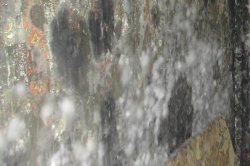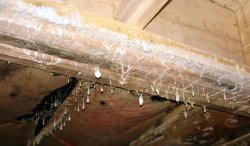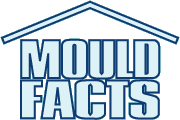Wednesday, February 21, 2007
White Mold
 What is white mold? Some molds may appear white at the early stage of their growth but change color with age (see the mold picture on the left). The reason is, with some molds the color we see is actually the color of the spores. The body of the mold (i.e., the network of filaments) is generally white or colorless. So, a mold may appear white before it produces spores and later appear black or blue after producing the colored spores. However, some molds have characteristic white color (regardless of age) since their spores are not pigmented. As with black mold, white mold is not a specific type of mold since a number of molds may appear white. White Mold Or Efflorescence?There are times when efflorescence is mistaken for white mold. Efflorescence is a white salt deposit commonly seen on concrete floors. As the water wicks up from the ground through the concrete it carries with it dissolved salts. When the water evaporates it leaves behind the visible white stuff which many homeowners mistake for mold.  How To Distinguish White Mold From EfflorescenceThe easiest way to distinguish white mold from efflorescence is to put some of the stuff into a drop of water. If it dissolves, it is not mold. Also, since efflorescence is crystallized salts, it breaks into a very fine powder if squeezed between fingers.
Sunday, February 18, 2007
What To Do If You Detect Mold In Your Home
If you detect mold in your home don't panic. The fact that you have seen visible mold growth doesn't necessarily mean your health or that of your family has been compromised. The health effects associated with common molds generally depend on the amount and type of mold present and sensitivity of the occupants. It is difficult to tell the type of mold by the colour. Some molds may appear black while others may appear white, blue, green or a shade of various colours. Black mold could be any mold. Be aware of the current misinformation regarding mold. One of such misinformation regards a mold called Stachybotrys or Stacky in short. Stachybotrys is commonly referred (though incorrectly) as the black mold. Although some species of Stachybotrys are highly toxigenic and may cause severe health effects from exposure, presence of black mold doesn't necessarily mean the health of the occupants has been affected. However, regardless of whether a mold is toxigenic or not, it should not be allowed to grow in occupied environments. So What Do You Do If You Detect Mold In Your Home?1. Send samples to a reputable laboratory for testing so that you know for sure what type of mold you are dealing with. The laboratory report includes a listing of the types of mold present in the samples and also information (where available) on whether the mold is known to be of health concern. 2. If the mold in your home is not toxigenic and it covers less than 10 square feet, you may be able to clean it yourself. If the mold is toxigenic or it covers more than 10 square feet, consult a mold professional. A professional would a assess the extent of mold growth and recommend a suitable level of mold remediation.
What To Do If You Detect Mold In Your Home
If you detect mold in your home don't panic. The fact that you have seen visible mold growth doesn't necessarily mean your health or that of your family has been compromised. The health effects associated with common molds generally depend on the amount and type of mold present and sensitivity of the occupants. It is difficult to tell the type of mold by the colour. Some molds may appear black while others may appear white, blue, green or a shade of various colours. Black mold could be any mold. Be aware of the current misinformation regarding mold. One of such misinformation regards a mold called Stachybotrys or Stacky in short. Stachybotrys is commonly referred (though incorrectly) as the black mold. Although some species of Stachybotrys are highly toxigenic and may cause severe health effects from exposure, presence of black mold doesn't necessarily mean the health of the occupants has been affected. However, regardless of whether a mold is toxigenic or not, it should not be allowed to grow in occupied environments. So What Do You Do If You Detect Mold In Your Home?1. Send samples to a reputable laboratory for testing so that you know for sure what type of mold you are dealing with. The laboratory report includes a listing of the types of mold present in the samples and also information (where available) on whether the mold is known to be of health concern. 2. If the mold in your home is not toxigenic and it covers less than 10 square feet, you may be able to clean it yourself. If the mold is toxigenic or it covers more than 10 square feet, consult a mold professional. A professional would a assess the extent of mold growth and recommend a the level of mold remediation required.
Sunday, February 11, 2007
Mold
What is Mold?Mold belongs to a group of organisms called fungi. Mold differ from other fungi in that their body is made of a network of thread-like structures or filaments. For mold to grow in buildings moisture, suitable temperature and food source must be present. Cellulose-containing materials such as dry wall, cardboard or any plant or animal based products are suitable food sources for molds. How Would One Recognize Mold?Mold growth is often associated with organic material such as cellulose-containing material that have been wet or damp for a prolonged period of time. Mold may appear as discolored, raised, wooly or hairly growth. Molds can be a variety of different colours, and may not be identified by colour alone. Why Is Mold a Health Concern?During growth mold may release spores into the air. Inhalation of these spores can result in a variety of health effects which can generally be categorized as infection, allergies or irritation. Of the three main categories of health effects, allergy is the most common, producing symptoms such as sneezing and coughing in affected individuals. People inhale airborne spores everyday, both indoors and outdoors. However the health effects associated with exposure to mold depend on a number of factors including: - Individual susceptibility – if a person’s immune system is weakened for any reason they may be at risk of mold exposure. Individuals undergoing medical treatment such as chemotherapy or kidney dialysis, expectant women, infants and elderly people should not be exposed to mold.
- Level of mold exposure – if exposed to high levels of mold over a long period of time, one may develop sensitivity to mold.
- Type of mold – certain types of molds are known to be more hazardous than others.
Some molds may produce toxins (mycotoxins) during their growth. Currently, health effects due airborne mycotoxins have not been established. However, ingestion of mycotoxins such as aflatoxin can be fatal.
Friday, February 09, 2007
Mold In Houses
Mold in houses is a health hazard, it's unsightly and also damages materials on which it is growing on. In houses mold can be found growing on walls, ceiling tiles, clothes, shoes, books, foodstuffs, and other valuable items. What Is The Source Of Mold In Houses?Mold in houses originates from outside environment in form of airborne spores and fragments. Outside the house, the molds grow on dead plant material (a few of these moulds are also capable of growing on living plants causing diseases) and produce spores which become airborne. The concentration of spores in the outside air reaches peak levels in summer. When we open our doors or windows, the spores and other mold fragments are blown into our houses by wind and settle on various surfaces. If the surface on which the spore has settled become wet, the spores germinate and if the material is organic such as paper, leather, and wood the germinated spores continues to develop into visible mold growth which in turn produces mores spores. A number of molds are also soil borne. These can be carried into houses by flood water or soiled shoes, implements or other articles. Frequent vacuum cleaning reduces spore load in houses. Labels: Mold
Wednesday, February 07, 2007
How To Get Rid of Black Mold Safely
How to remove mold safelyAs the saying goes "prevention is better than cure". Similarly, preventing mold from growing in your home is better than trying to remove it. Proper maintenance of a building is the key to control of mold growth. Regardless of whether one is dealing with "black mold" or not, it should be removed safely. If you've found a small amount of surface mold (less than 1 square meter or 3 square feet) growing in your home, you may clean it yourself. It is highly recommended that you consult a mold remediation specialist if the mold you find is larger than 1 square meter. And do not attempt to remove areas of mold that are greater than 10 square meters. Refer to the mold remediation guidelines for more information. Steps to take to get rid of moldBefore you clean, you may want to find out whether the mold you've found is toxic or merely of cosmetic concern. Our visible mold test kit will let you know for sure. If it is toxic, you may want to call a mold remediation specialist even if the area is small. If you decide to clean small amounts of mold yourself, please take precautions. Disturbing mold may release harmful spores into the air, which can worsen allergy and asthma symptoms or cause your family to feel ill if the mold is toxic. For complete instructions on how to remove mold safely in your house (remember extensive mold contamination requires removal by trained people), read the Mould Guidelines for the Canadian Construction Industry available at the website of the Canadian Construction Association. - Wear disposable (throwaway) cloth, gloves and a dust mask
- Enclose the area with plastic sheet to contain dust and prevent spread of spores
- Turn the furnace or air conditioner off before you start
- If the mold is growing on hard surfaces, simply wash, and dry the area thoroughly. Ensure the moisture problem is fixed even before attempting to clean the mold. It's a good idea to check the area regularly to be sure the clean up was effective
- If mold is growing on surfaces that cannot be cleaned such as porous material, cut off the contaminated material and replace them with new material.
For a more detailed treatment of mold removal read the Mould Guidelines for the Canadian Construction Industry.
Monday, February 05, 2007
Black Mold
Black Mold and my Home
It can be nerve-wracking if you either suspect or know that black mold is growing in your home. Media sensationalism has caused a great deal of fear about black mold. But not all black molds are toxic, and not all toxic molds are black. What is Black Mold?
The term black mold does not refer to a specific type of mold. However, the term is used eroneously to refer to Stachybotrys chartarum. Stachybotrys chartarum is the infamous black mold associated with lung bleeding and the deaths of infants in Cleveland, Ohio in the 1990's. When wet, Stachybotrys may appear greenish black and slimy, but can also look sooty and black. It's been associated with a number of health problems some of which are highly controversial. These include inflammation of the skin, cough, running nose, nose bleeds, a burning sensation in the mouth and nasal passage, cold and flu symptoms, headache, general fatigue, and fever. Black Mold On WindowsillsCladosporium may appear black and is very common on windowsills. Many home occupants panic when they see this black mold growing on the windows. It is good to know that Cladosporium is not toxigenic. However, it is allergenic meaning that some people may express allergic reactions if they inhale airborne spores of Cladosporium. Another mold that may appear black is Ulocladium. This may be found growing on damp walls. Ulocaldium is also not known to be toxigenic. Next time we will discuss How To Get Rid of Black Mold Safely
|
 What is white mold? Some molds may appear white at the early stage of their growth but change color with age (see the mold picture on the left). The reason is, with some molds the color we see is actually the color of the spores. The body of the mold (i.e., the network of filaments) is generally white or colorless. So, a mold may appear white before it produces spores and later appear black or blue after producing the colored spores. However, some molds have characteristic white color (regardless of age) since their spores are not pigmented. As with black mold, white mold is not a specific type of mold since a number of molds may appear white.
What is white mold? Some molds may appear white at the early stage of their growth but change color with age (see the mold picture on the left). The reason is, with some molds the color we see is actually the color of the spores. The body of the mold (i.e., the network of filaments) is generally white or colorless. So, a mold may appear white before it produces spores and later appear black or blue after producing the colored spores. However, some molds have characteristic white color (regardless of age) since their spores are not pigmented. As with black mold, white mold is not a specific type of mold since a number of molds may appear white.


